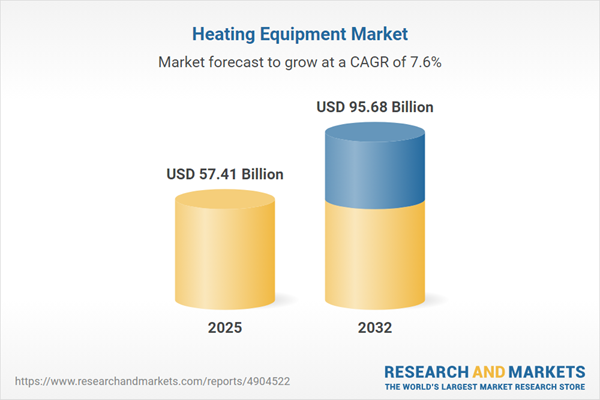Speak directly to the analyst to clarify any post sales queries you may have.
Senior leaders in the heating equipment industry are confronting a pivotal period marked by evolving regulations, ambitious sustainability benchmarks, and rapid technological advances. Effective navigation of these shifts is essential for operational stability, cost control, and competitive positioning in a complex, fast-changing market landscape.
Market Snapshot: Heating Equipment Market Size and Growth
The global heating equipment market is valued at USD 53.41 billion in 2024, with expectations to reach USD 57.41 billion in 2025 and a forecasted growth to USD 95.68 billion by 2032. This momentum translates to a compound annual growth rate (CAGR) of 7.56%.
The sector’s expansion is fueled by digital transformation, the adoption of advanced electric heating solutions, and mounting pressure to decarbonize. Regulatory reforms and sustainability objectives are prompting major investments in system modernization, innovative procurement processes, and infrastructure upgrades. Industry competitors are emphasizing adaptability, driving the adoption of resilient solutions and robust operational agility to enhance market responsiveness.Scope & Segmentation: Heating Equipment Market
- Fuel Types: Solutions include biomass-based systems such as those using wood pellets and chips, diverse electric heating methods, gas systems powered by natural gas and LPG, oil-fired units, and solar technologies. This diversity enables organizations to align heating strategies with energy targets and compliance needs.
- Product Types: Options cover condensing and non-condensing boilers, various electric and gas furnaces, a broad spectrum of heat pumps (air-source and ground-source), convection heaters, and fan-driven units. Each technology offers versatile deployment across settings from industrial floors to offices and multi-unit residential buildings.
- Mechanism: Systems span ducted and ductless forced air, hydronic heating via radiators or baseboards, and radiant solutions for floors and ceilings. These mechanisms enable integrative approaches for retrofits and new installations, supporting optimized energy management and seamless building integration.
- End Users: The market addresses commercial environments, hospitality venues, industrial operations, and residential customers, each of which faces distinct challenges around compliance, integration of intelligent controls, and ensuring ongoing system performance.
- Distribution Channels: The value chain includes dealer networks, direct distribution, OEMs, contractors, direct sales teams, online market platforms, and specialty retailers. This variety is crucial for reliable delivery, project flexibility, and timely after-sales support.
- Regional Coverage: Market coverage spans the Americas, Europe, Asia-Pacific, and the Middle East & Africa, where regional policy shifts and regulatory priorities create specific demands on product design and implementation, requiring localized approaches and strategy adaptation.
- Key Companies: Prominent players such as Daikin Industries, Carrier Global, Trane Technologies, Lennox International, Johnson Controls, Robert Bosch, Vaillant Group, Viessmann Werke, Rheem Manufacturing, and A. O. Smith Corporation are continuously setting benchmarks in technology standards and environmental performance.
Key Takeaways for Senior Decision-Makers
- Electrification and advanced heat pump technologies are actively enabling organizations to transition away from legacy fuels and achieve longer-term sustainability ambitions.
- Frequent regulatory changes require highly flexible sourcing and procurement strategies, ongoing investment in digital platforms, and strict programs to ensure operational compliance.
- Deploying intelligent analytics and real-time monitoring enhances operational oversight, supporting uninterrupted system performance and streamlining preventive maintenance for critical assets.
- Integrating digital technologies into established infrastructures supports efficient resource use, manages transformation risk, and maintains business continuity during upgrades.
- Agile adaptation of distribution and service channels—especially through digitalization—facilitates faster turnaround for equipment needs across varied property portfolios and operating environments.
- Tailoring regional distribution strategies ensures equipment aligns with local legislative requirements and aids organizations in responding to shifting market and regulatory conditions efficiently.
Tariff Impact on Supply Chains and Pricing
Imposed U.S. tariffs on heating equipment components have led companies to reevaluate sourcing and supply chain strategies. Nearshoring manufacturing, expanding regional facilities, and diversifying supplier networks are among the emerging approaches to manage price fluctuations and reinforce supply continuity. Emphasis on expanding vertical integration is also supporting greater operational flexibility as organizations adapt to international trade dynamics.
Methodology & Data Sources
This report leverages comprehensive regulatory and patent reviews, technical research, and expert interviews. Data validation utilizes trade analytics, end-to-end shipment monitoring, and benchmarking of supplier performance to ensure high-confidence insights into industry trends and competitive practices.
Why This Report Matters to Executives
- Assists in aligning investment and operational strategies with evolving regulatory and sustainability priorities for stronger risk mitigation.
- Delivers timely sector intelligence to uncover growth opportunities, streamline compliance, and optimize supply chain flows using proven benchmarks.
- Enables sharper resource planning and procurement decision-making to secure strong competitive positioning in a shifting global regulatory context.
Conclusion
Senior decision-makers gain targeted, actionable insights for achieving operational resilience and sustainable progress amid ongoing change in the heating equipment market. This report is designed to equip leadership with the clarity to anticipate and address regulatory and technological shifts confidently.
Additional Product Information:
- Purchase of this report includes 1 year online access with quarterly updates.
- This report can be updated on request. Please contact our Customer Experience team using the Ask a Question widget on our website.
Table of Contents
3. Executive Summary
4. Market Overview
7. Cumulative Impact of Artificial Intelligence 2025
Companies Mentioned
The companies profiled in this Heating Equipment market report include:- Daikin Industries, Ltd.
- Carrier Global Corporation
- Trane Technologies Company PLC
- Lennox International Inc.
- Johnson Controls International PLC
- Robert Bosch GmbH
- Vaillant Group GmbH
- Viessmann Werke GmbH & Co. KG
- Rheem Manufacturing Company
- A. O. Smith Corporation
Table Information
| Report Attribute | Details |
|---|---|
| No. of Pages | 199 |
| Published | November 2025 |
| Forecast Period | 2025 - 2032 |
| Estimated Market Value ( USD | $ 57.41 Billion |
| Forecasted Market Value ( USD | $ 95.68 Billion |
| Compound Annual Growth Rate | 7.5% |
| Regions Covered | Global |
| No. of Companies Mentioned | 11 |









